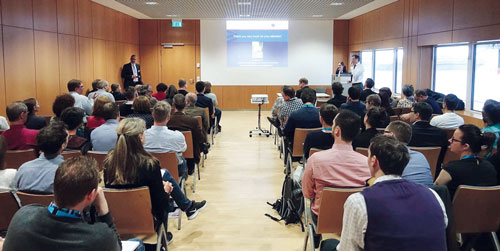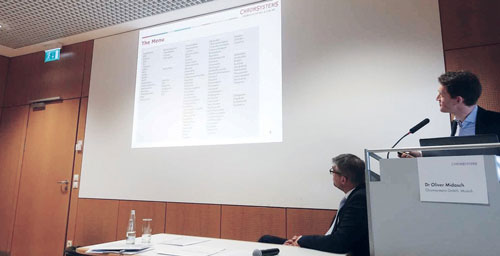Drugs of Abuse Testing and Antibiotics


Chromsystems Workshop at Analytica 2018
On the 11th of April, Chromsystems held its Workshop on Drugs of Abuse Testing and Antibiotics at Analytica 2018. Chromsystems welcomed up to 100 guests, who listened to interesting talks surrounding these topics.
DoA – From Screening to Confirmation
The demand for drug testing is swiftly becoming daily routine in laboratory workplaces. Traditionally, it is recommended to perform a confirmatory test using LC-MS/MS for urine samples that tested positive in an immunoassay.
Katja Ackermann, MVZ Labor 28 (Berlin) presented an application study that validated a LC-MS/MS method for the qualitative and quantitative analysis of urine drugs of abuse and their metabolites. The lab performed this analytical method developed by Chromsystems and demonstrated that the new LC-MS/MS assay was more useful for the detection of urine drugs of abuse compared to the established immunoassay.
Dr Christoph Geffert from Labor Staber Dresden-Klipphausen presented a comparison of a new LC-MS/MS assay with an established GC-MS method. He showed the suitability and reliability of the assay for the determination of these substances in their study. The outcome is comparable with results from reference methods, therefore the new LC-MS/MS assay can be applied to confirmation analyses for drugs of abuse in driving aptitude tests according to GTFCh guidelines. Due to the reduction in labor-intensive sample preparation and reduced sample volume, the assay also offers advantages for daily laboratory routines.
Dr Midasch from Chromsystems presented a new assay for the determination of more than 100 Drugs of Abuse by LC-MS/MS. “Both, targeted screening and quantitative confirmation are possible with the same setup”, he explained. The assay is a complete solution that can be implemented into an existing LC-MS/MS system within a few days and without the need for extensive validation studies. More information on the new Chromsystems assay is available on the Drugs of Abuse product page.
The demand for drug testing is swiftly becoming daily routine in laboratory workplaces. Traditionally, it is recommended to perform a confirmatory test using LC-MS/MS for urine samples that tested positive in an immunoassay.


TDM of Antibiotics – when and how?
Therapeutic monitoring of antibiotics is particularly important for drugs with a narrow therapeutic concentration spectrum, or for those with a high risk of toxic side effects. More accurate, and individualized, monitoring can also optimize the therapeutic efficiency, while reducing the risk of any resistance developing. Consequently, labs are looking into introducing TDM for these drugs. The aim: an optimal patient care in collaboration with the treating physician.
Prof. Holdenrieder at the German Heart Centre (Munich) reported on an interdisciplinary program of physicians, pharmacy, hygienics, microbiology and laboratory medicine, which combines specialist knowledge from experts across all fields for optimal drug assessment and therapeutic counselling. Recent experiences in implementing HPLC methods for the quantification of antibiotics meropenem, linozelide, piperacillin, ampicillin, cefipim and ceftazidim were also presented and discussed.
Dr Heike Schneider from the Klinikum rechts der Isar (Munich) reported on a successful proficiency pilot test that was carried out in January 2018. It covered ampicillin, cefepime, ceftazidime, linezolid, meropenem, piperacillin, sulbactam and tazobactam. The study aimed to support a better standardization of monitoring of these drugs. “There are plans to establish a regular quality assessment scheme in the near future”, Schneider added.
Dr Oliver Midasch emphasized that, so far, there has been no commercially available method for these antibiotics. But he showcased the new Chromsystems assay for HPLC; that, with a simple sample preparation, combined with the chromatographic setup, a fast and secure determination of these important substances can be achieved without the requirement of highly sophisticated lab equipment. Two internal standards are used for a precise quantification and stable calibration. “Control materials are also available to ensure accuracy of results”, Midasch added.
